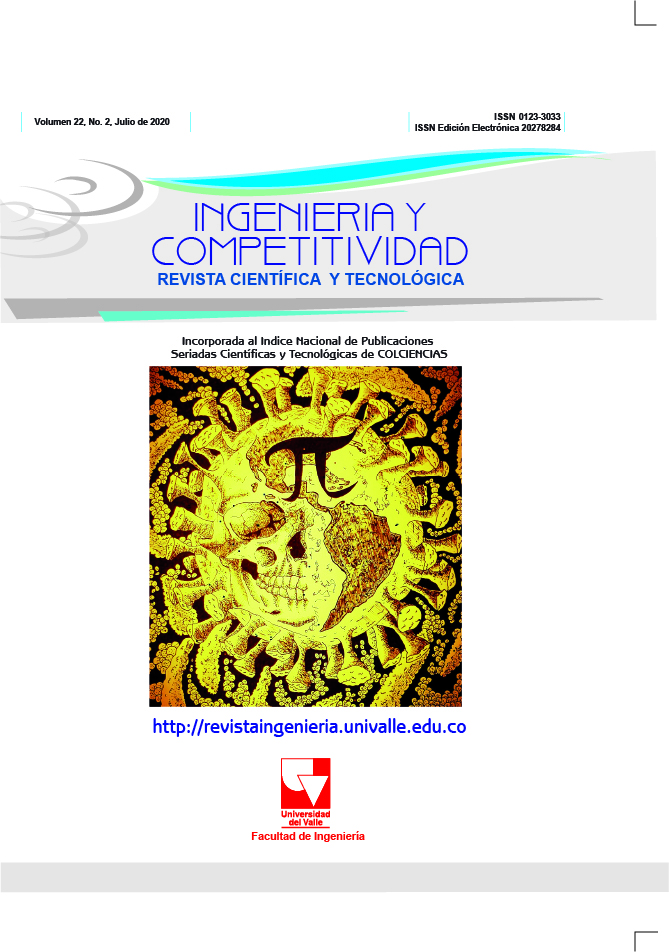Tratamiento de lixiviado de relleno sanitario mediante acople tecnológico de Biorreactor Laguna Anaerobia de Alta Tasa- BLAAT® y Humedal Construido Subsuperficial de Flujo Horizontal sembrado con policultivos
Contenido principal del artículo
El lixiviado de relleno sanitario (LX), es un líquido con un gran potencial eco-toxicológico que se genera como producto de la mezcla de agua lluvia que percola por el relleno y tiene contacto con el residuo sólido (RS) allí depositado, agua producida de la biodegradación de los residuos y el agua propia que contienen los residuos. El uso de eco-tecnologías (humedales construidos, lagunas algales) por las grandes ventajas ecológicas y ambientales exhibidas, han comenzado a emplearse en el tratamiento de LX con resultados bastante alentadores. En este sentido, la presente investigación desarrollada en el relleno sanitario de Presidente, municipio de San Pedro, Valle del Cauca, Colombia en el 2015, estuvo orientada a evaluar a escala piloto el uso del acople eco-tecnológico Biorreactor Laguna Anaerobia de Alta Tasa BLAAT® + humedal construido (HC) sembrado con policultivos de las especies tropicales Colocasia esculenta-Ce, Heliconia psittacorum-He y Gynerium sagittatum-Gs, para el tratamiento de LX bajo condiciones del trópico americano. Este trabajo coloca a disposición una serie de datos de campo sobre la calidad del lixiviado crudo y del efluente de cada unidad de tratamiento, mostrando el desempeño del acople, lo que puede contribuir al establecimiento de condiciones y escenarios para el tratamiento de este en poblaciones que dispongan condiciones cultural y ambiental similares a la zona del presente estudio.
- Biorreactor BLAAT®
- Fitorremediación
- Humedal construido
- Lixiviado
- Policultivo
(1) Zhang Qi Q., Hu Tian B., Zhang X, Ghulam A., Ran Fang C., He R. Investigation on characteristics of leachate and concentrated leachate in three landfill leachate treatment plants. Waste management. 2014;33(11): 2277-2286. Doi: 10.1016/j.wasman.2013.07.021.
(2) Renou S., Givaudan, J.G., Poulain, S., Dirassouyan, F., and Moulin, P. Landfill leachate treatment: review and opportunity. Journal of Hazardous Materials. 2008;150(3): 468-493. Doi: 10.1016/j.jhazmat.2007.09.077.
(3) Salem Z., Hamouri K., Djemaa R., Allia K. Evaluation of landfill leachate pollution and treatment. Desalination. 2008;220(1-3): 108-114. Doi: 10.1016/j.desal.2007.01.026.
(4) Oman C B., Junestedt C. Chemical characterization of landfill leachates – 400 parameters and compounds. Waste Management. 2008; 28(10): 1876-1891. Doi: 10.1016/j.wasman.2007.06.018.
(5) Yao P. Perspectives on technology for landfill leachate treatment. Arabian Journal of Chemistry. 2017; 10(2): S2567-S2574. Doi: 10.1016/j.arabjc.2013.09.031.
(6) Noguera-Oviedo K., Olivero-Verbel j. Los rellenos sanitarios en Latinoamérica: caso colombiano. REV ACAD COLOMB CIENC. XXXIV. 2010;34(132): 347-356.
(7) BUGASEO SA ESP. Informe del sistema de tratamiento de lixiviado-Relleno sanitario de presidente. Buga: BUGASEO SA ESP; 2009.
Descargas

Esta obra está bajo una licencia internacional Creative Commons Atribución-NoComercial-CompartirIgual 4.0.
Los autores que publican en esta revista están de acuerdo con los siguientes términos:
Los autores ceden los derechos patrimoniales a la revista y a la Universidad del Valle sobre los manuscritos aceptados, pero podrán hacer los reusos que consideren pertinentes por motivos profesionales, educativos, académicos o científicos, de acuerdo con los términos de la licencia que otorga la revista a todos sus artículos.
Los artículos serán publicados bajo la licencia Creative Commons 4.0 BY-NC-SA (de atribución, no comercial, sin obras derivadas).





